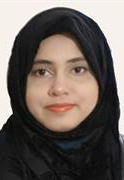|
Both webinars listed below were moderated by IEEE VTS Young Professionals Representative Taimoor Abbas.

Ferheen Ayaz and Maziar Nekovee, University of Sussex
Speaker: Dr. Ferheen Ayaz, livestreamed on 8 February 2024
Abstract—The increasing number of Electric Vehicles (EVs) has led to rising energy demands which aggregates the burden on grid supply. A few solutions have been proposed to achieve demand and supply balance, for example, using storage systems for storing surplus energy from EVs or scheduling supply from the grid according to varying demand at different times. However, these solutions are costly and their applicability is limited to specific regions and times.
This talk proposes a smart energy management solution for a massively electrified road transport network. It comprises of energy supplies from the grid, charging stations, distributed renewable sources, and EVs connected by 5G-enabled aggregators.
This work proposes EVs as prosumers, which are energy consumers but also supply back their surplus energy via bidirectional Vehicle-to-Grid (V2G) technology. We have used machine learning models to forecast hourly energy output from renewable sources, surplus supply from EVs, and their demands. A grid cost minimization solution is proposed using Mixed Integer Linear Programming which dynamically alters supply according to demand and energy provision from EVs.
The proposed solution also considers penalty charges for CO2 emissions during energy generation. The upper bounds of surplus supply and demand of EVs are theoretically derived. An incentive distribution mechanism is also presented to reward EVs by offering their surplus supply and to discourage them from becoming selfish which is analyzed using Prisoner's dilemma game. Additionally, an optimum number of charging stations on a road considering the incentives of EVs and their maximum contribution in supplying energy are estimated.
Simulation results show that the proposed solution can effectively meet the demand requirements with the increasing number of EVs, even if the supply from the grid is limited.
Ferheen Ayaz is a Research Fellow at the 6G Lab, School of Engineering and Informatics, University of Sussex working on the Network Plus Project “A Green, Connected and Prosperous Britain” funded by the EPSRC. She is formulating energy-efficient solutions for electric vehicle charging utilizing vehicle-to-grid (V2G) networks enabled by 5G communication. Previously, she worked on the security of deep neural networks for IoT devices at the University of Glasgow. She completed her Ph.D. thesis at the University of Sussex on the topic of blockchain solutions for the security and privacy of vehicular networks, particularly message dissemination. She has published in various IEEE flagship conferences and prestigious journals. She volunteers for the IEEE Young Professionals Climate and Sustainability Task Force and has also served IEEE Women in Engineering UK and Ireland Group and N2Women Network.

Luca Lusvarghi, Universidad Miguel Hernandez de Elche
Livestreamed on 11 December 2023
Abstract—Over the last years, the onset of Vehicle-to-Everything (V2X) communications paved the way for the evolution of Intelligent Transportation Systems (ITS) towards connected and autonomous driving. In this regard, the Third Generation Partnership Project (3GPP) has introduced the Cellular V2X (C-V2X) standard in Release 14 specifications to support basic safety-related applications and enhanced V2X use cases in both in-coverage and out-of-coverage scenarios. In the latter case, dedicated Medium Access Control (MAC) layer protocols allow connected vehicles to autonomously select their transmission resources and directly communicate, without the support of the cellular infrastructure.
However, distributed C-V2X communications rely on poorly flexible scheduling algorithms that are not able to effectively serve the generated traffic when the packet inter-arrival time and the packet size are not fixed.
To this end, this seminar will illustrate the potential of Artificial Intelligence (AI) techniques to address these challenges and to improve the performance of distributed C-V2X communications. During the seminar, the impact of a Machine Learning (ML) algorithm on the dissemination of Cooperative Awareness Messages (CAMs) will also be demonstrated through simulation results.
Luca Lusvarghi received the Master’s degree (summa cum laude) in Electronics Engineering and the PhD in ICT from the University of Modena and Reggio Emilia (Italy) in July 2019 and March 2023, respectively. Currently, he is a postdoc researcher at the UWICORE laboratory of the Universidad Miguel Hernandez (UMH) de Elche, Spain. His research interests focus on 6G and beyond technologies for connected and automated mobility, particularly on cognitive networks and semantic communications for V2X. |